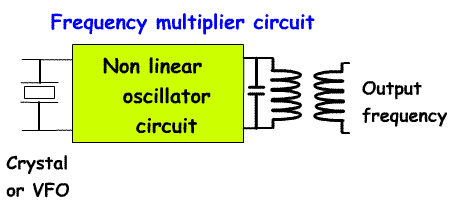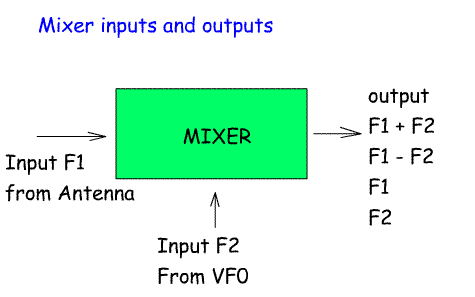
| ADVANCED LESSON 36 |  |
| LEARNING OBJECTIVES and NOTES | |
| Frequency multipliers | |
|
4d.1 Understand that frequency multipliers use harmonics to generate
frequencies above an oscillator’s fundamental frequency (e.g. in a
microwave transmitter) Sometimes we need a very high frequency to be generated, for example for a microwave transmitter. We already know that an oscillator produces multiples of the fundamental frequency called harmonics. In a frequency multiplier circuit we take advantage of this by using a non-linear circuit to create more harmonic content. We then use a bandpass filter to select the frequency required and to reject the fundamental and other harmonics. As an example: The crystal frequency is 44MHz. This will produce outputs of: The Fundamental = 44 MHz 2nd Harmonic= 88 MHz 3rd Harmonic = 132 MHz 4th Harmonic =176 MHz 5th Harmonic =220MHz 6th Harmonic =264MHz 7th Harmonic= 308MHz 8th Harmonic =352MHz 9th Harmonic =396 MHz 10th Harmonic =440 MHz 11th Harmonic =484 MHz 12th Harmonic =528 MHz 13th Harmonic =572 MHz 14th Harmonic = 616 MHz If we wanted an output of 572 MHz the multiplier tuned circuit would be designed for this frequency. Stability of the oscillator is even more important in frequency multipliers. At 14 times the funfamemtal the harmonic would fall on 616MHz. Any change in crystal frequency will also be multiplied by 14! |
 |
| Mixers | |
|
4e.1 Understand that the desired frequency is often produced by mixing
together the output from two or more frequency sources, e.g. VFO,
crystal oscillator or synthesiser. Mixers are used in various stages of modern transceivers. E.g. mixer VFOs, where a VFO output is mixed with a crystal to produce a higher frequency. Synthesisers where the output from the fixed divider is mixed with the output from a programmable divider to produce a control voltage for the VCO. How do mixers work? If two frequencies (F1 and F2) are fed into a mixer The output frequencies will include: F1 F2 F1 + F2 F1 - F2 Plus lots of other frequencies. So if we want a 10.7MHz output from a mixer from a 3.5MHz signal we could mix it with a frequency of: 14.2 - 3.5 = 10.7 or 7.2 + 3.5 = 10.7 |
 |
|
Understand how unwanted frequencies may also be produced. In a receiver the desired output from the mixer is the IF frequency. However unwanted frequencies can be produced. Particularly if these are close to the wanted IF. In addition if strong signals enter the mixer intermodulation products may also be produced. This is dealt with later in the course. |